Chemical and Rheological Evaluation of Aged Lignin-Modified Bitumen
Abstract
1. Introduction
2. Objective and Approach
- Examine the effect of lignin on bitumen performance. Also, few studies focused on the aging of lignin and, thus, the aged lignin was evaluated using ESEM and FTIR spectroscopy.
- Assess the effect of aging on lignin-modified bitumen. ESEM, FTIR, and DSR tests were conducted on samples in order to explore the microstructural, chemical, compositional, and rheological changes of new binders.
3. Materials and Methods
3.1. Materials and Samples Preparation
3.2. Microstructural Morphology
3.3. Chemical Characterization
3.4. Rheological Characterization
3.4.1. Frequency Sweep Tests
3.4.2. Linear Amplitude Sweep Tests
3.4.3. Relaxation Tests
3.4.4. Glover–Rowe Parameter Tests
4. Results and Discussion
4.1. Microstructural Observation
4.2. Chemical Characterization
4.3. Rheological Characterization
4.3.1. Frequency Sweep Tests
4.3.2. Linear Amplitude Sweep Tests
4.3.3. Relaxation Tests
4.3.4. Glover–Rowe Parameter Tests
5. Conclusions
- After aging, the specific surface area of lignin particles decreases. The microstructure of bitumen with and without lignin is almost the same. However, it becomes difficult to observe the worm structure of bitumen after aging and the addition of lignin.
- The results from FTIR tests show that the various functional groups of lignin do not change remarkably during aging, and carbonyl and sulfoxide indices can still be used to assess the aging state of lignin-modified bitumen.
- The effect of lignin added in advance or after aging has little effect on the viscoelastic characteristics of bitumen. The physical interaction between lignin and bitumen plays an important role, as shown by the changes in complex modulus, phase angle, crossover modulus, and crossover frequency.
- The addition of lignin slightly reduces the fatigue life based on the results of LAS tests. As bitumen ages, its fatigue life increases at low strain levels and decreases at high strain levels due to the stiffening effect.
- The addition of lignin does not improve the relaxation properties dramatically. However, the aging of lignin itself and the moment that lignin is added to the bitumen has an effect on the relaxation properties, especially the relaxation ratio of residual and initial shear stress and the relaxation time to certain stress levels.
- Based on the results calculated by the Glover–Rowe parameter method, lignin provides an improvement in cracking resistance. Nevertheless, the aging of lignin itself and the moment that lignin is added to the bitumen have little impact on the cracking sensitivity of bitumen.
Author Contributions
Funding
Acknowledgments
Conflicts of Interest
References
- Apostolidis, P.; Liu, X.; Kasbergen, C.; Scarpas, T. Synthesis of Asphalt Binder Aging and the State of the Art of Antiaging Technologies. Transp. Res. Rec. 2017, 2633, 147–153. [Google Scholar] [CrossRef]
- Chailleux, E.M.; Audo, B.; Bujoli, C.; Queffelec, J.; Legrand; Lepine, O. Alternative Binder from Microalgae: Algoroute Project. In Proceedings of the Transportation Research E-Circular, Washington, DC, USA, 22 January 2012; pp. 7–14. [Google Scholar]
- Audo, M.; Paraschiv, M.; Queffelec, C.; Louvet, I.; Hemez, J.; Fayon, F.; Lepine, O.; Legrand, J.; Tazerout, M.; Chailleux, E.; et al. Subcritical Hydrothermal Liquefaction of Microalgae Residues as a Green Route to Alternative Road Binders. ACS Sustain. Chem. Eng. 2015, 3, 583–590. [Google Scholar] [CrossRef]
- Gosselink, R.J.A. Lignin as a Renewable Aromatic Resource for the Chemical Industry. Ph.D. Thesis, Wageningen University, Wageningen, The Netherlands, 2011. [Google Scholar]
- Bruijnincx, P.; Gruter, G.-J.; Westenbroek, A.; Engelen-Smeets, E. Lignin Valorisation: The Importance of a Full Value Chain Approach; Utrecht University: Utrecht, The Netherlands, 2016. [Google Scholar]
- Sundestrom, D.W.; Klel, H.E.; Daubenspeck, T.H. Use of Byproduct Lignins as Extenders in Asphalt. Ind. Eng. Chem. Prod. Res. Dev. 1983, 22, 496–500. [Google Scholar] [CrossRef]
- McCready, N.S.; Williams, R.C. Utilization of Biofuels Coproducts as Performance Enhancers in Asphalt Binder. Transp. Res. Rec. 2008, 2051, 8–14. [Google Scholar] [CrossRef]
- Xu, G.; Wang, H.; Zhu, H. Rheological Properties and Anti-aging Performance of Asphalt Binder modified with Wood Lignin. Constr. Build. Mater. 2017, 151, 801–808. [Google Scholar] [CrossRef]
- Pan, T.A. First-principle based Chemophysical Environment for Studying Lignins as an Asphalt Antioxidant. Constr. Build. Mater. 2012, 36, 654–664. [Google Scholar] [CrossRef]
- Pan, T.; Cheng, C. An Ab Initio Molecular Dynamics Analysis of Lignin as a Potential Antioxidant for Hydrocarbons. J. Mol. Graph. Model. 2015, 62, 325–341. [Google Scholar] [CrossRef]
- Batista, K.B.; Padilha, R.P.L.; Castro, T.O.; Silva, C.F.S.C.; Araujo, M.F.A.S.; Leite, L.F.M.; Pasa, V.F.C.; Lins, V.M.D. High-temperature, Low-temperature and Weathering Aging Performance of Lignin modified Asphalt Binders. Ind. Crop. Prod. 2018, 111, 107–116. [Google Scholar] [CrossRef]
- Arafat, S.; Kumar, N.; Wasiuddin, N.M.; Owhe, E.O. Lynam. Sustainable Lignin to Enhance Asphalt Binder Oxidative Aging Properties and Mix Properties. J. Clean. Prod. 2019, 217, 456–468. [Google Scholar] [CrossRef]
- Perez, I.P.; Rodriguez Pasandin, A.M.; Pais, J.C.; Pereira, P.A.A. Use of Lignin Biopolymer from Industrial Waste as Bitumen Extender for Asphalt Mixtures. J. Clean. Prod. 2019, 220, 87–98. [Google Scholar] [CrossRef]
- Van Vliet, D.; Slaghek, T.; Giezen, C.; Haaksman, I. Lignin as a Green Alternative for Bitumen. In Proceedings of the 6th Euroasphalt & Eurobitume Congress, Prague, Czech, 1–3 June 2016. [Google Scholar]
- Yang, X.; Mills-Beale, J.; You, Z. Chemical Characterization and Oxidative Aging of Bio-asphalt and its Compatibility with Petroleum Asphalt. J. Clean. Prod. 2017, 142, 1837–1847. [Google Scholar] [CrossRef]
- Kassem, E.; Khan, M.S.; Katukuri, S.; Sirin, O.; Muftah, A.; Bayomy, F. Retarding Aging of Asphalt Binders using Antioxidant Additives and Copolymers. Int. J. Pavement Eng. 2019, 20, 1154–1169. [Google Scholar] [CrossRef]
- He, M.; Tu, C.; Cao, D.W.; Chen, Y.J. Comparative Analysis of Bio-binder Properties derived from Different Sources. Int. J. Pavement Eng. 2019, 20, 792–800. [Google Scholar] [CrossRef]
- Boeriu, C.G.; Bravo, D.; Gosselink, R.J.; van Dam, J.E. Characterisation of Structure-dependent Functional Properties of Lignin with Infrared Spectroscopy. Ind. Crop. Prod. 2004, 20, 205–218. [Google Scholar] [CrossRef]
- Dizhbite, T.; Telysheva, G.; Jurkjane, V.; Viesturs, U. Characterization of the Radical Scavenging Activity of Lignins-Natural Antioxidants. Bioresour. Technol. 2004, 95, 309–317. [Google Scholar] [CrossRef]
- Vinardell, M.P.; Ugartondo, V.; Mitjans, M. Potential Applications of Antioxidant Lignins from Different Sources. Ind. Crop. Prod. 2008, 27, 220–223. [Google Scholar] [CrossRef]
- ASTM D 6521-19. Standard Practice for Accelerated Aging of Asphalt Binder Using a Pressurized Aging Vessel (PAV); ASTM: West Conshohocken, PA, USA, 2019. [Google Scholar]
- Mikhailenko, P.; Kou, C.; Baaj, H.; Poulikakos, L.; Cannone-Falchetto, A.; Besamusca, J.; Hofko, B. Comparison of ESEM and Physical Properties of Virgin and Laboratory Aged Asphalt Binders. Fuel 2019, 235, 627–638. [Google Scholar] [CrossRef]
- Lamontagne, J.; Dumas, P.; Mouillet, V.; Kister, J. Comparison by Fourier Transform Infrared (FTIR) Spectroscopy of Different Ageing Techniques: Application to Road Bitumens. Fuel 2001, 80, 483–488. [Google Scholar] [CrossRef]
- Bykov, I. Characterization of Natural and Technical Lignins Using FTIR Spectroscopy. Master Thesis, Lulea University of Technology, Luleå, Sweden, 2008. [Google Scholar]
- Petersen, J.C. A Review of the Fundamentals of Asphalt Oxidation: Chemical, Physicochemical, Physical Property, and Durability Relationships. In Transportation Research E-Circular; The National Acdemies of Sciences Engineering Medicine: Washington, DC, USA, 2009. [Google Scholar]
- AASHTO T 315-19. Standard Method of Test for Determining the Rheological Properties of Asphalt Binder Using a Dynamic Shear Rheometer (DSR); AASHTO: Washington, DC, USA, 2019. [Google Scholar]
- AASHTO TP 101-14. Standard Method of Test for Estimating Damage Tolerance of Asphalt Binders Using the Linear Amplitude Sweep; AASHTO: Washington, DC, USA, 2014. [Google Scholar]
- Hintz, C.; Bahia, H. Simplification of Linear Amplitude Sweep Test and Specification Parameter. Transp. Res. Rec. 2013, 2370, 10–16. [Google Scholar] [CrossRef]
- Anderson, M.; Le Hir, Y.M.; Marasteanu, M.O.; Planche, J.-P.; Martin, D.; Gauthier, G. Evaluation of Fatigue Criteria for Asphalt Binders. Transp. Res. Rec. 2001, 1766, 48–56. [Google Scholar] [CrossRef]
- Jing, R. Ageing of Bituminous Materials: Experimental and Numerical Characterization. Ph.D. Thesis, Delft University of Technology, Delft, The Netherlands, 2019. [Google Scholar]
- Airey, G.D. Use of Black Diagrams to identify Inconsistencies in Rheological Data. Road Mater. Pavement Des. 2002, 3, 403–424. [Google Scholar] [CrossRef]
- Mensching, D.J.; Rowe, G.M.; Daniel, J.S.; Bennert, T. Exploring Low-temperature Performance in Black Space. Road Mater. Pavement Des. 2015, 16, 230–253. [Google Scholar] [CrossRef]
- King, G.; Anderson, M.; Hanson, D.; Blankenship, P. Using Black Space Diagrams to Predict Age-induced Cracking. In 7th RILEM International Conference on Cracking in Pavements; Scarpas, A., Kringos, N., Al-QadiLoizos, I., Loizos, A., Eds.; Springer: Berlin, Germany, 2012; pp. 453–463. [Google Scholar]
- Rahalkar, R.R. Correlation between the Crossover Modulus and the Molecular Weight Distribution using the Doi-Edwards Theory of Reptation and the Rouse Theory. Rheol. Acta 1989, 28, 166–175. [Google Scholar] [CrossRef]
- Scarsella, M.; Mastrofini, D.; Barré, L.; Espinat, D.; Fenistein, D. Petroleum Heavy Ends Stability: Evolution of Residues Macrostructure by Aging. Energy Fuel 1999, 13, 739–747. [Google Scholar] [CrossRef]
- Jing, R.; Varveri, A.; Liu, X.; Scarpas, A.; Erkens, S. Rheological, Fatigue and Relaxation Properties of Aged Bitumen. Int. J. Pavement Eng. 2019, 1–10. [Google Scholar] [CrossRef]
- Jing, R.; Varveri, A.; Xueyan, L.; Scarpas, T.; Erkens, S. Ageing Effect on the Relaxation Properties of Bitumen. In Proceedings of the Advances in Materials and Pavement Prediction: Papers from the International Conference on Advances in Materials and Pavement Performance Prediction (AM3P 2018), Doha, Qatar, 16–18 April 2018. [Google Scholar]
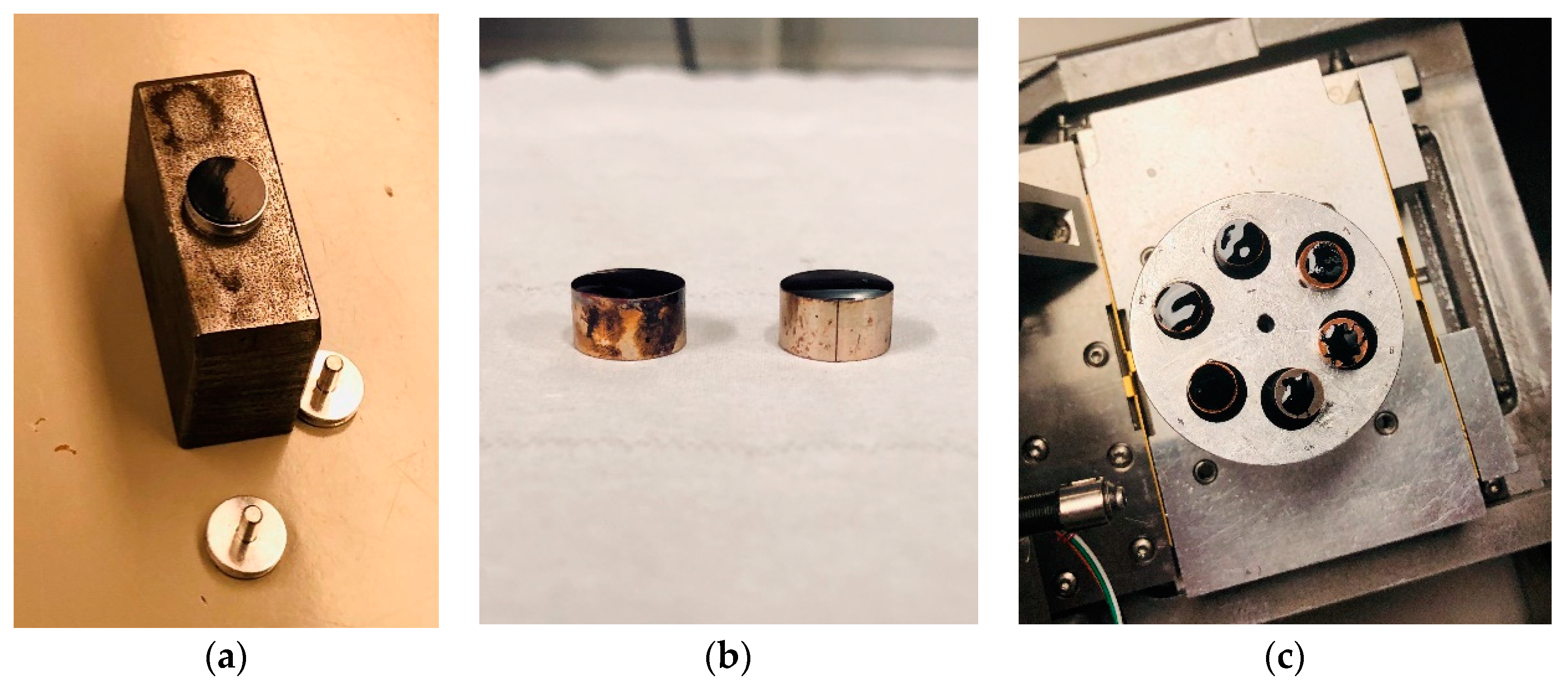
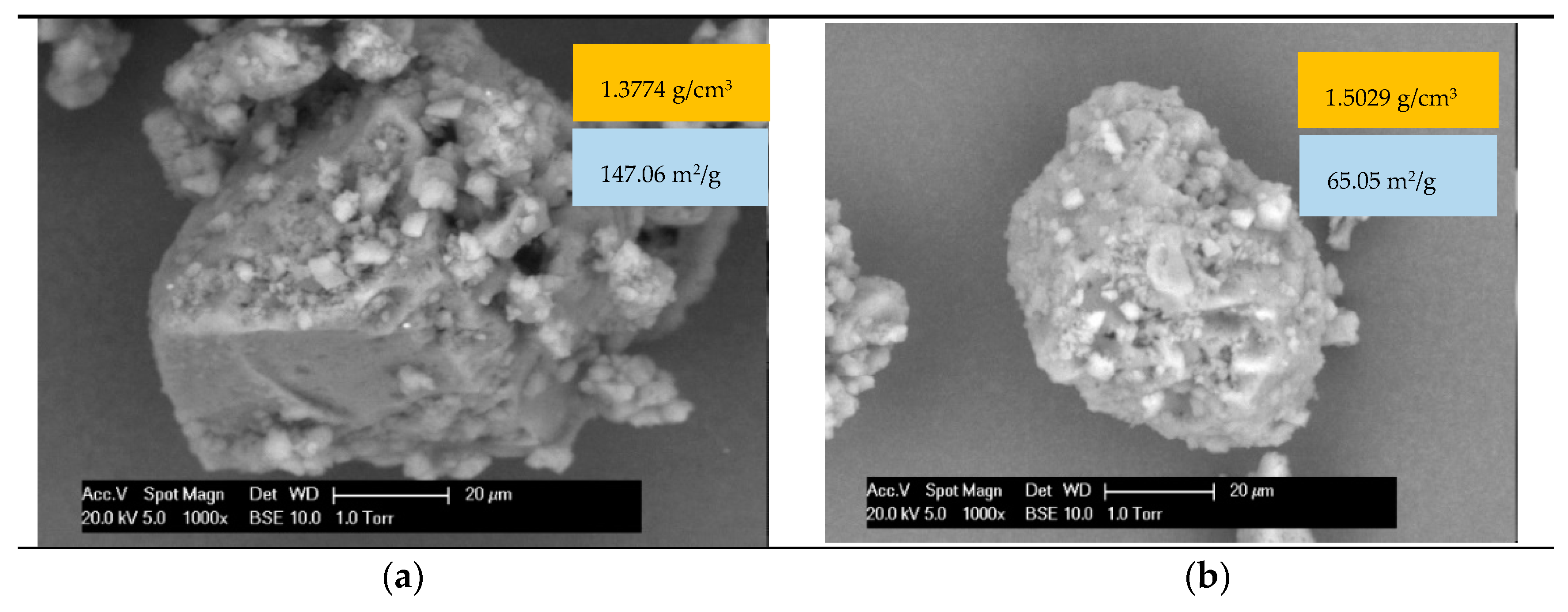
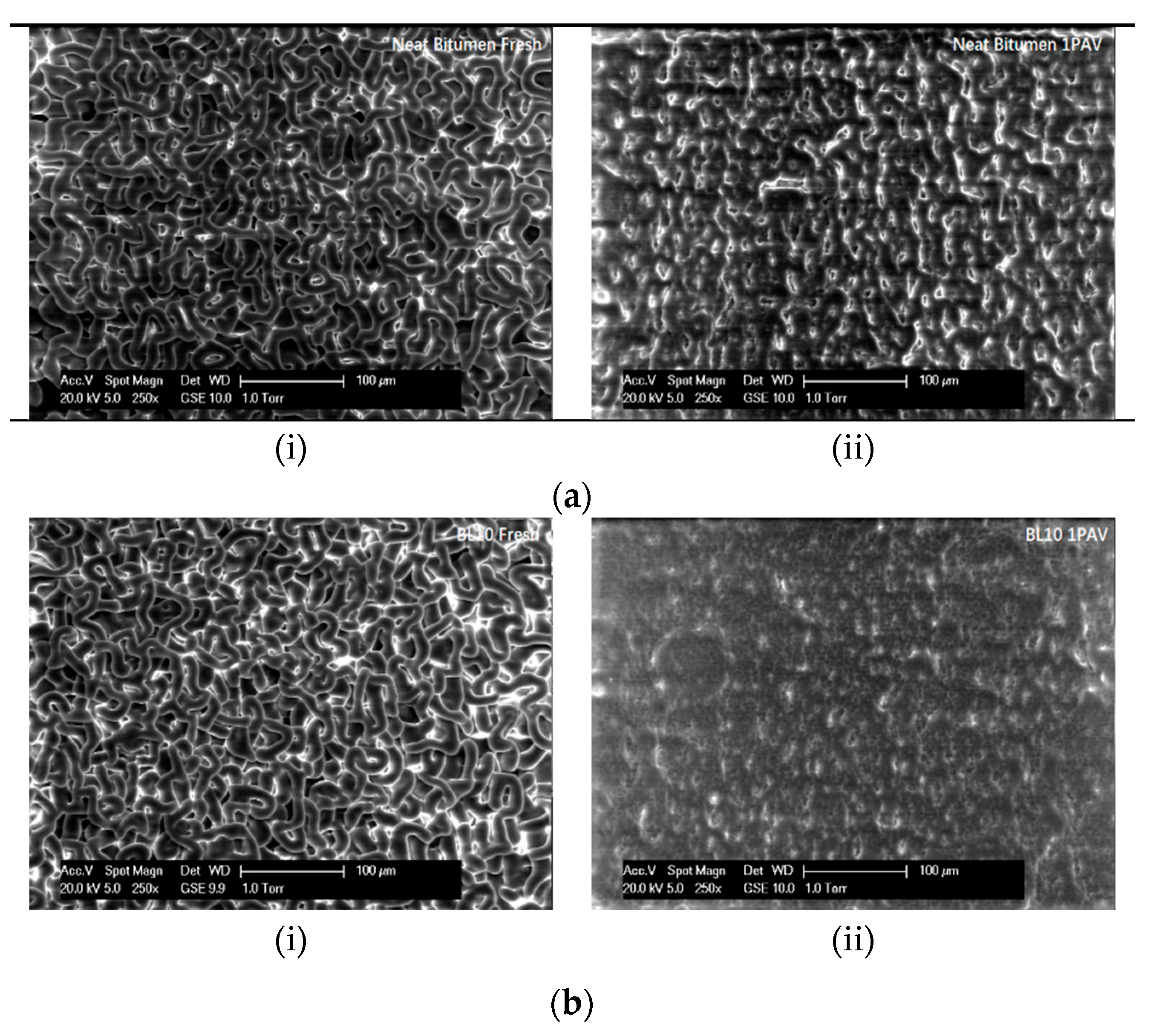
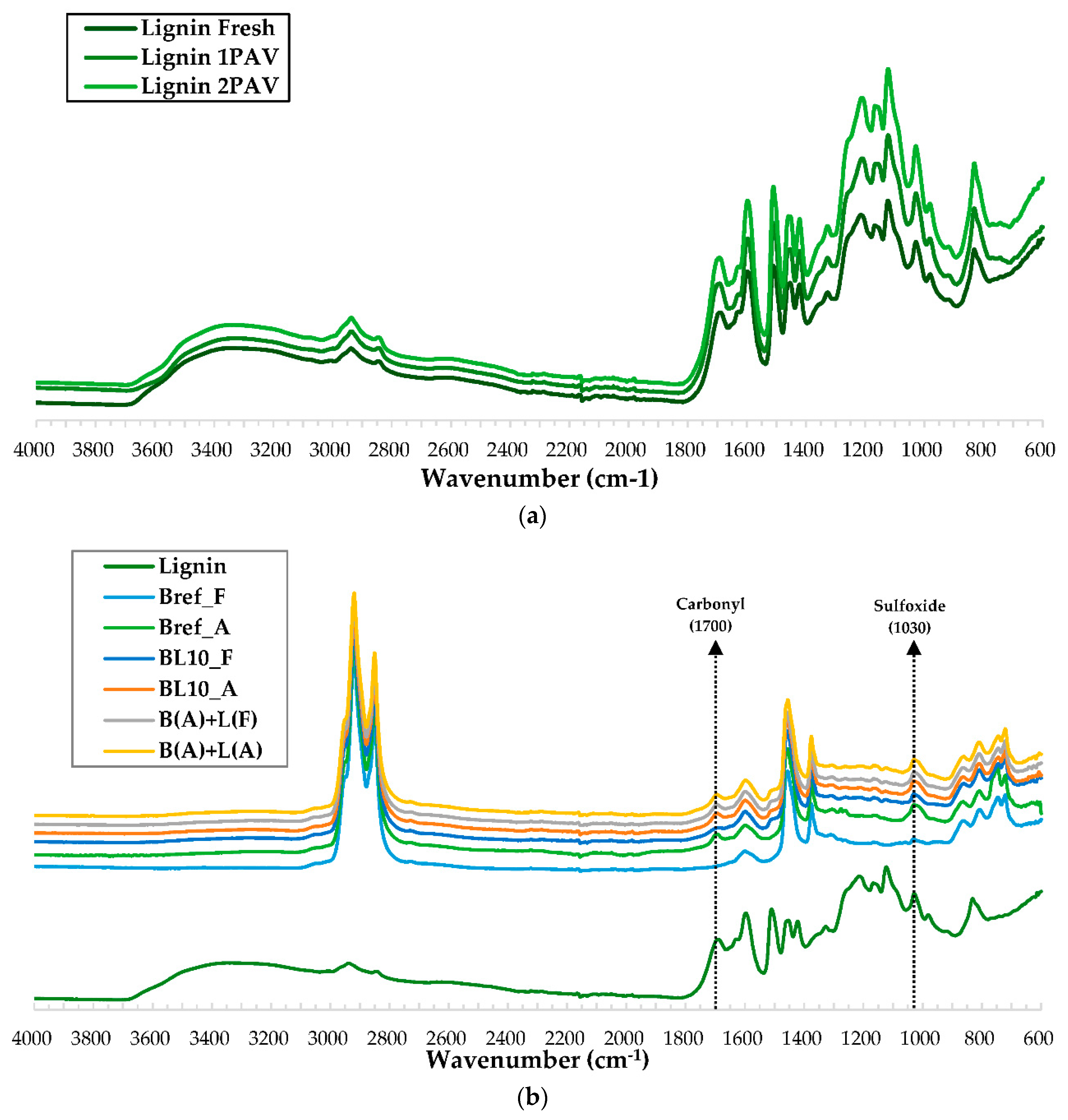
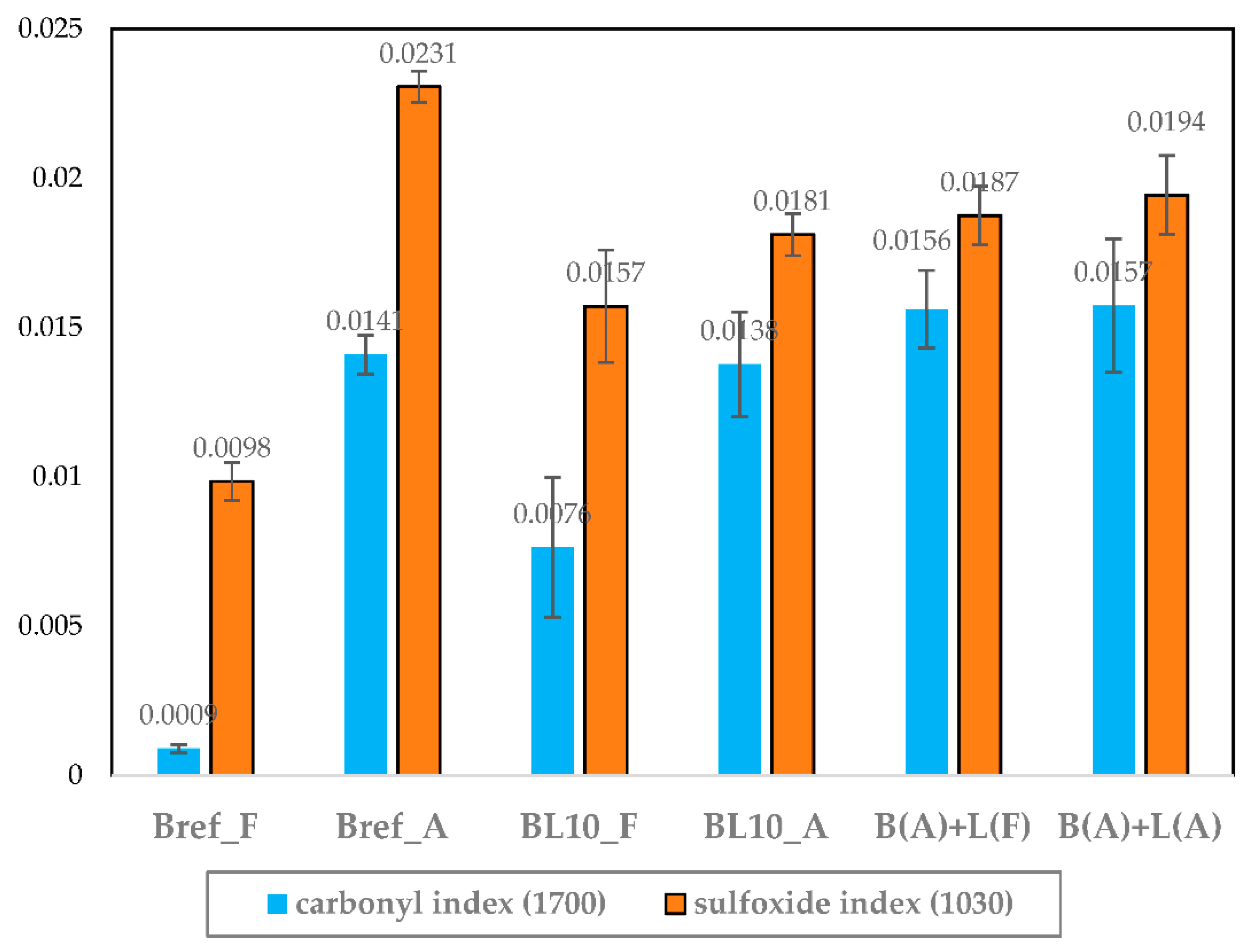
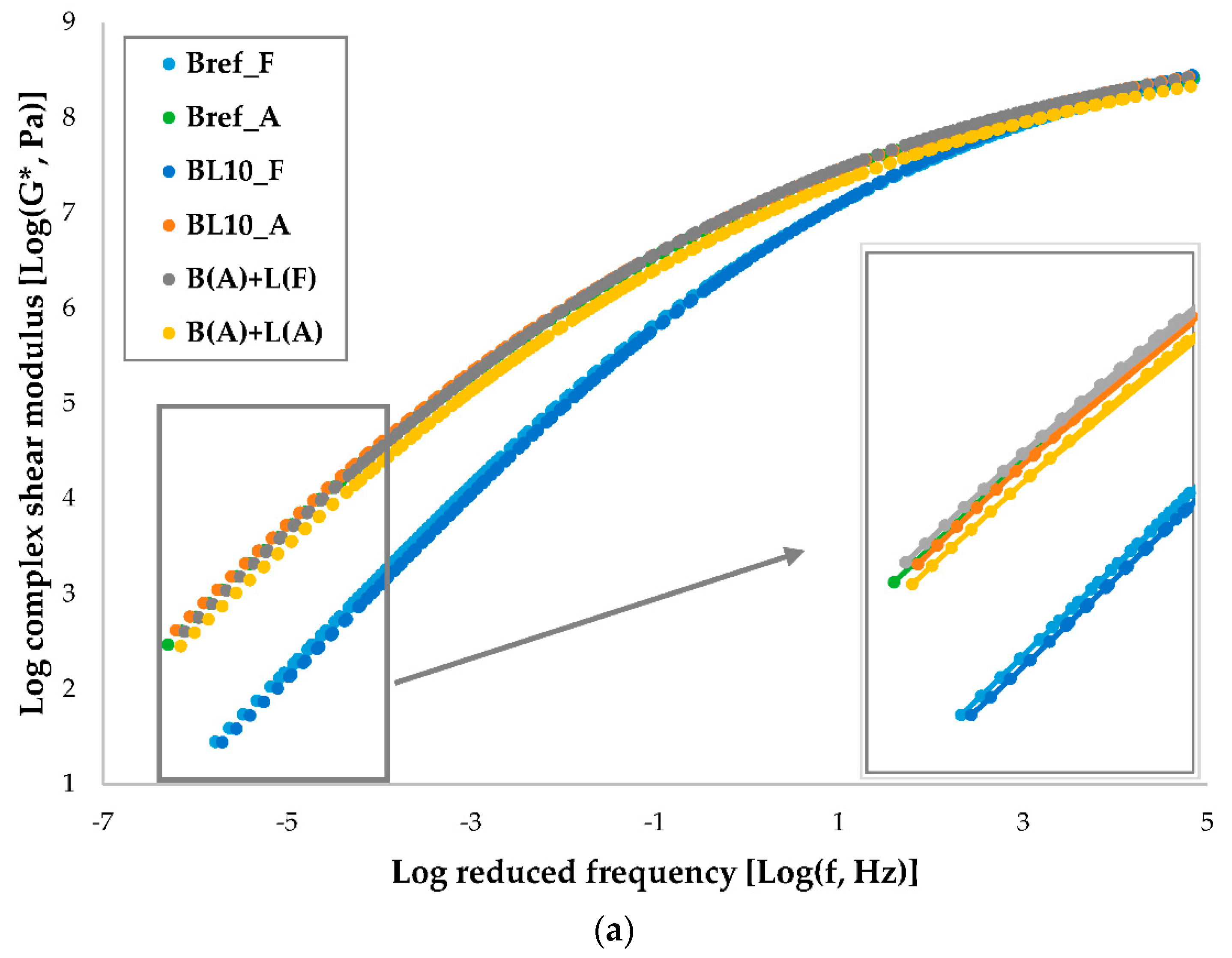
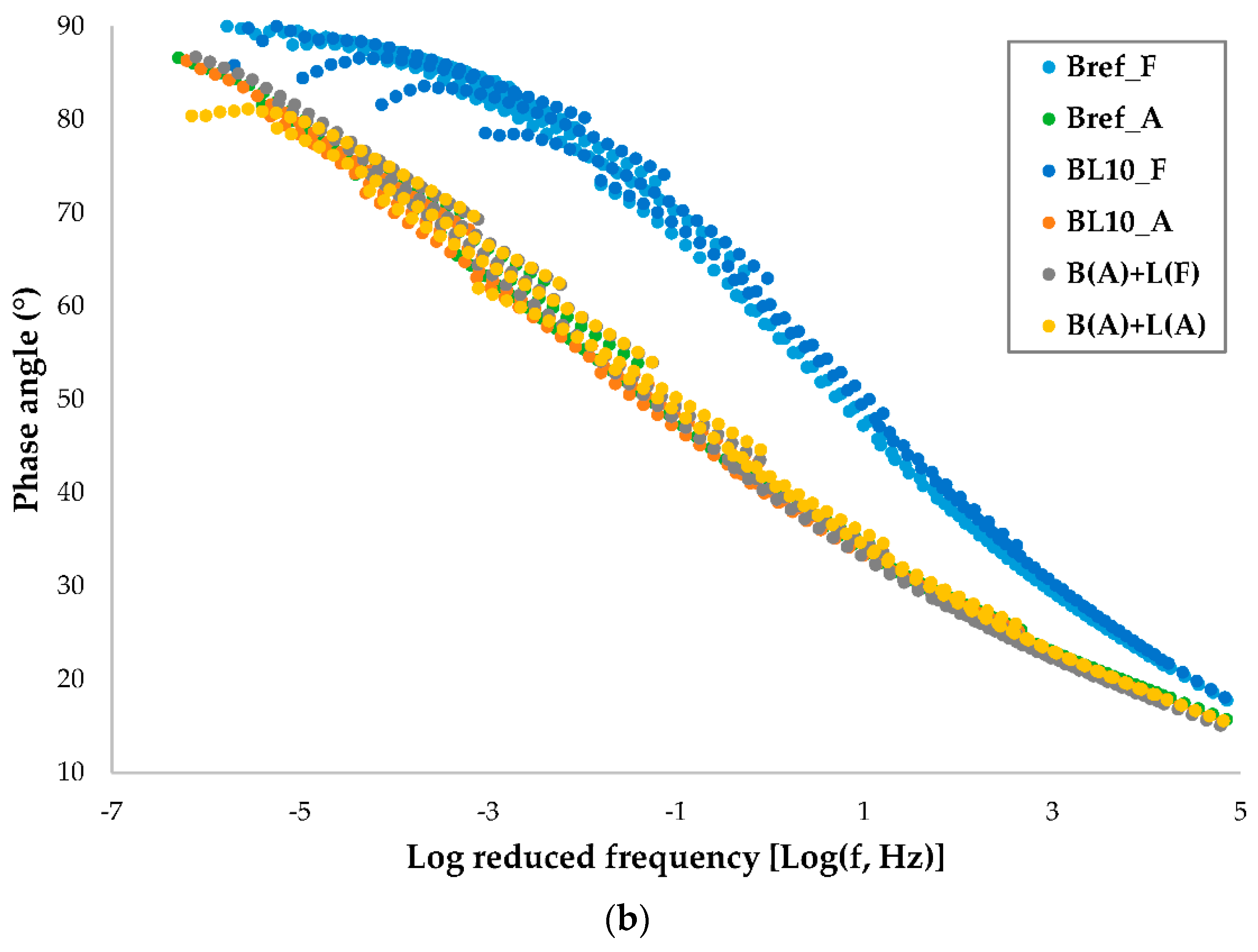
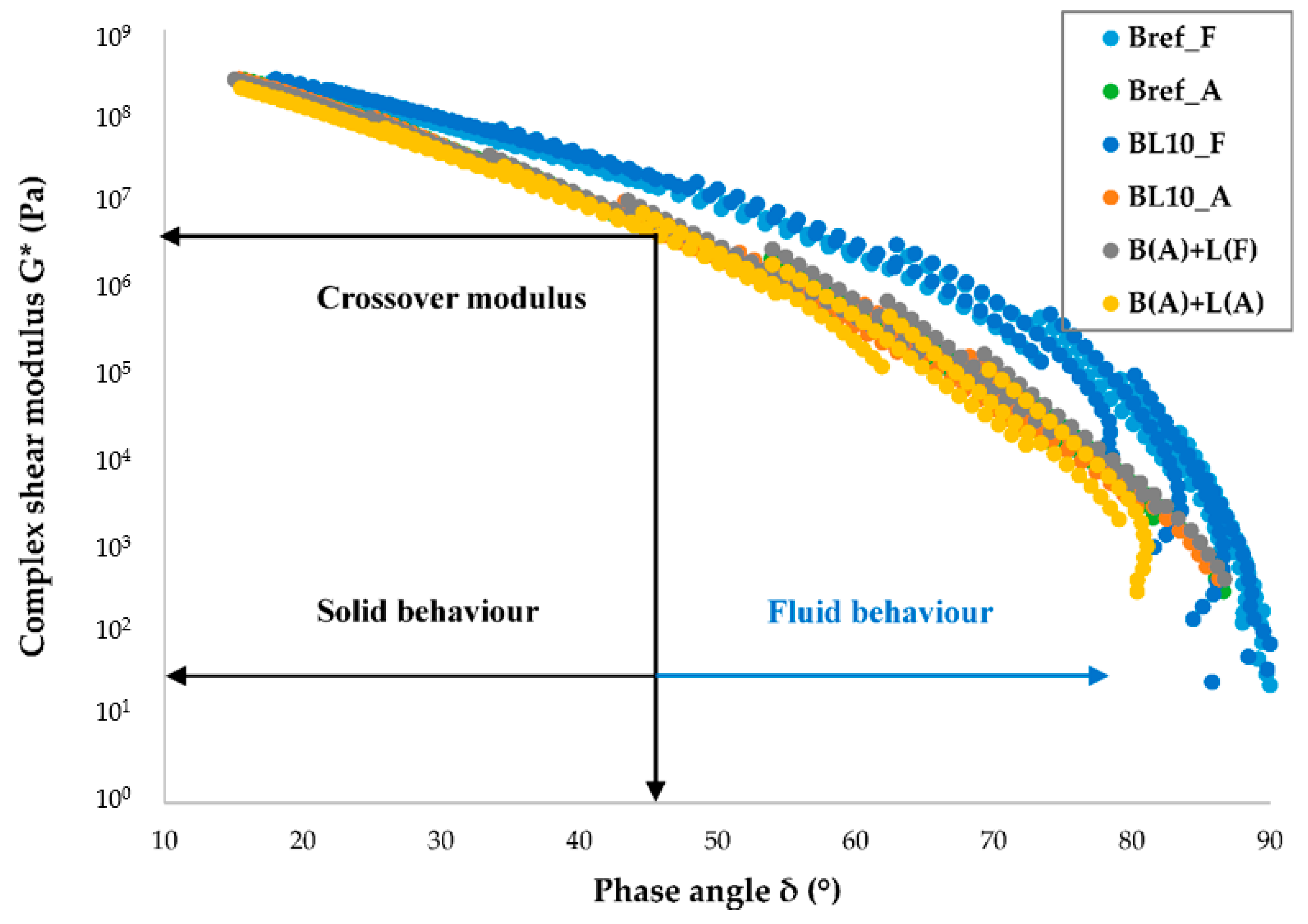
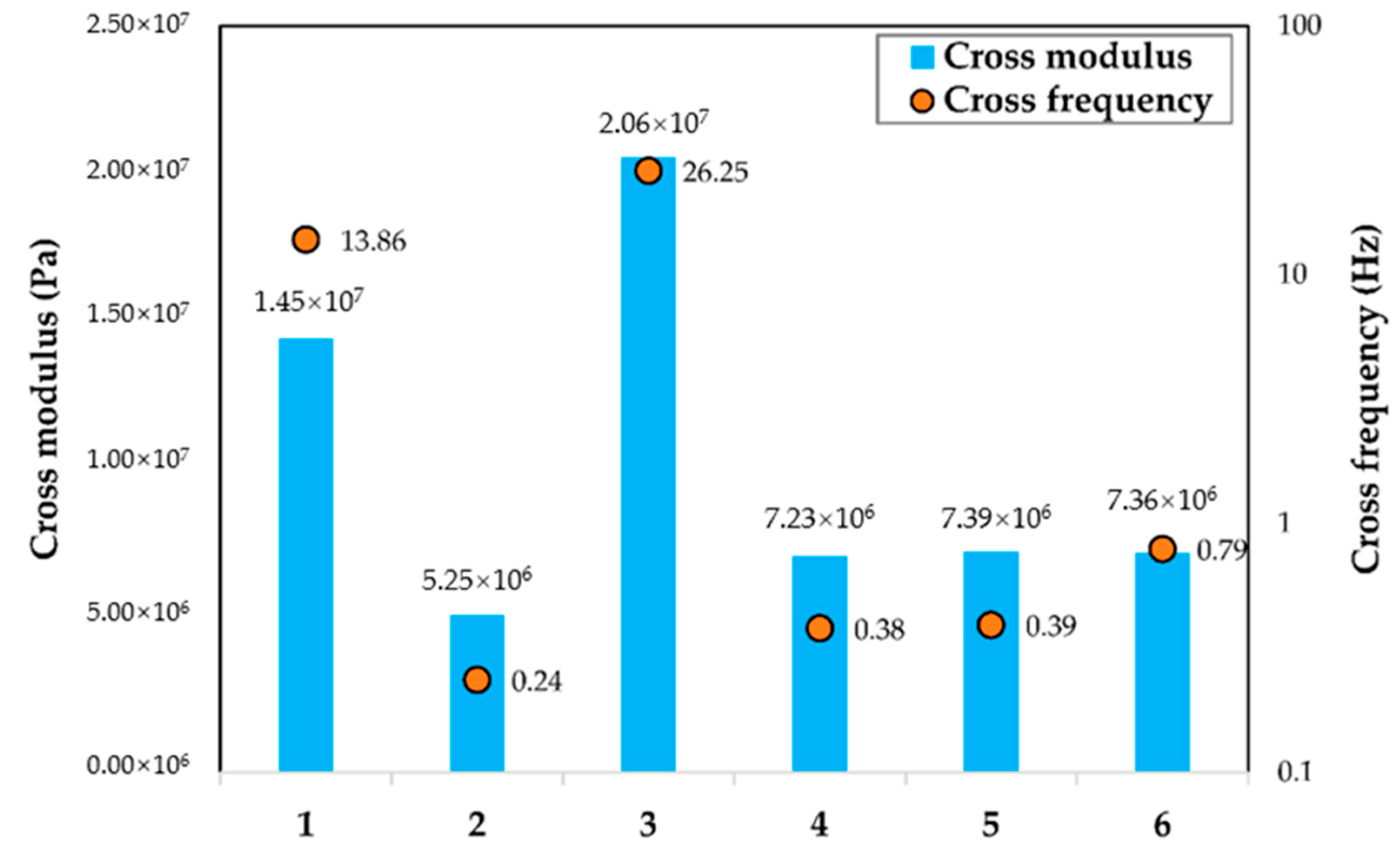
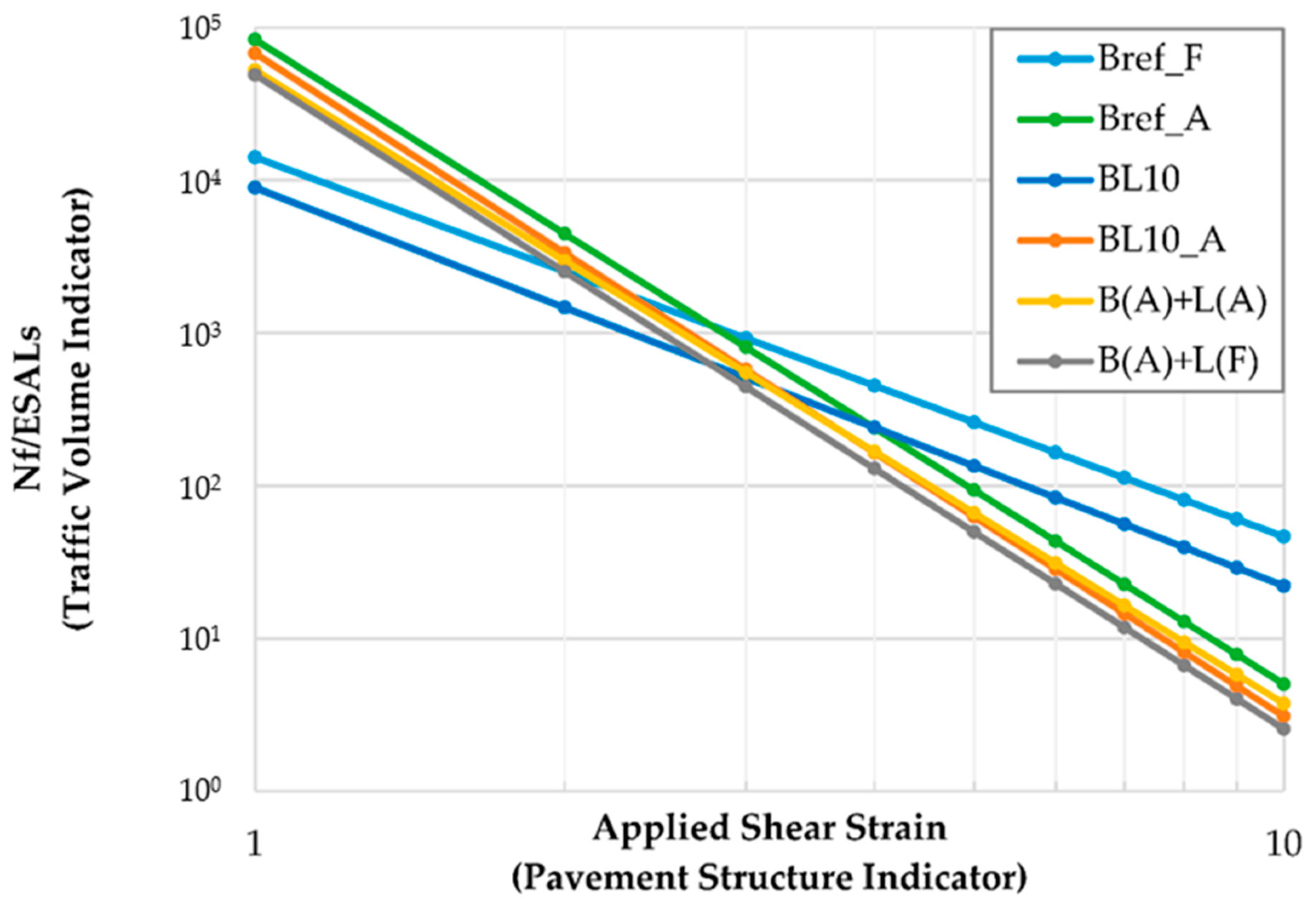
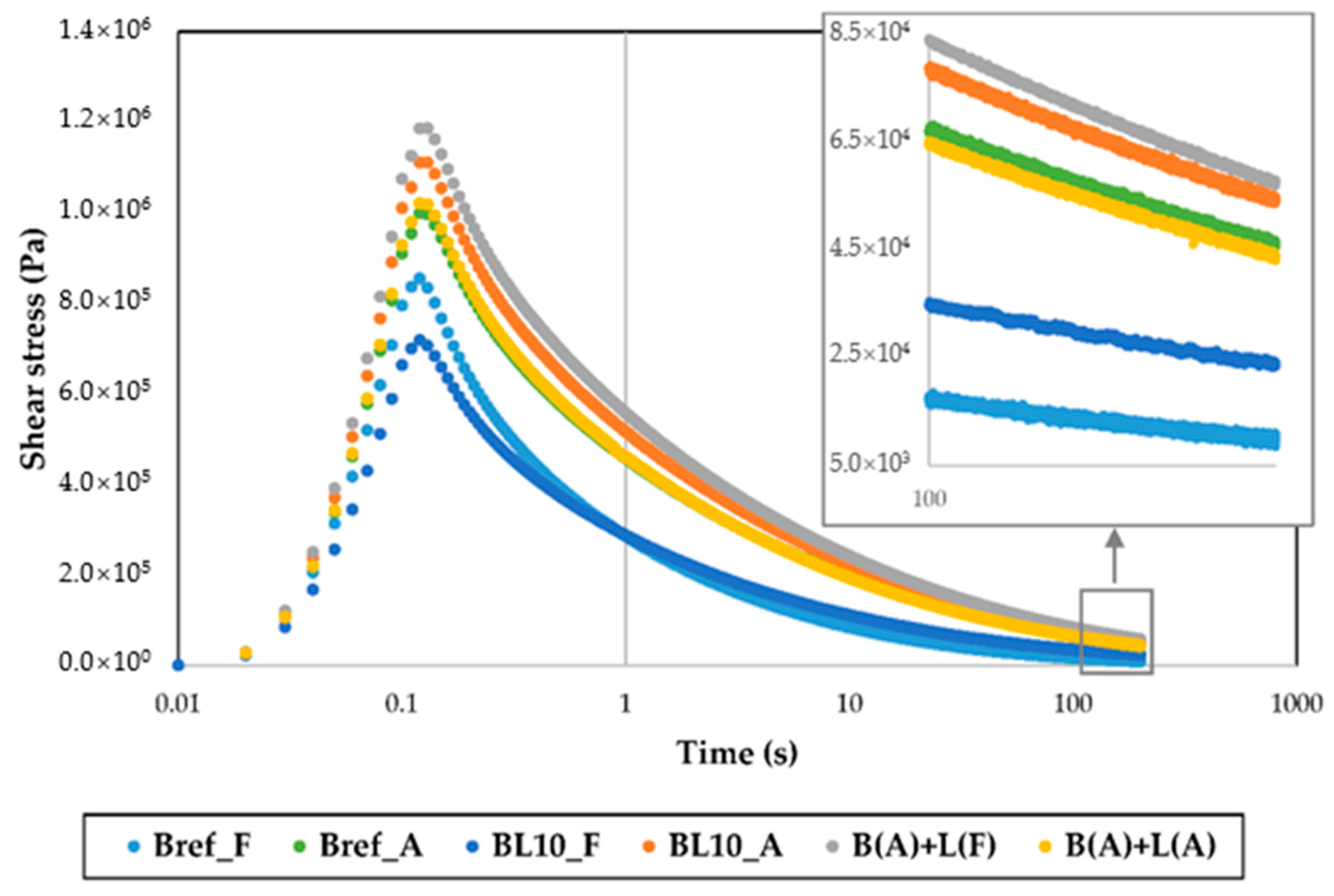
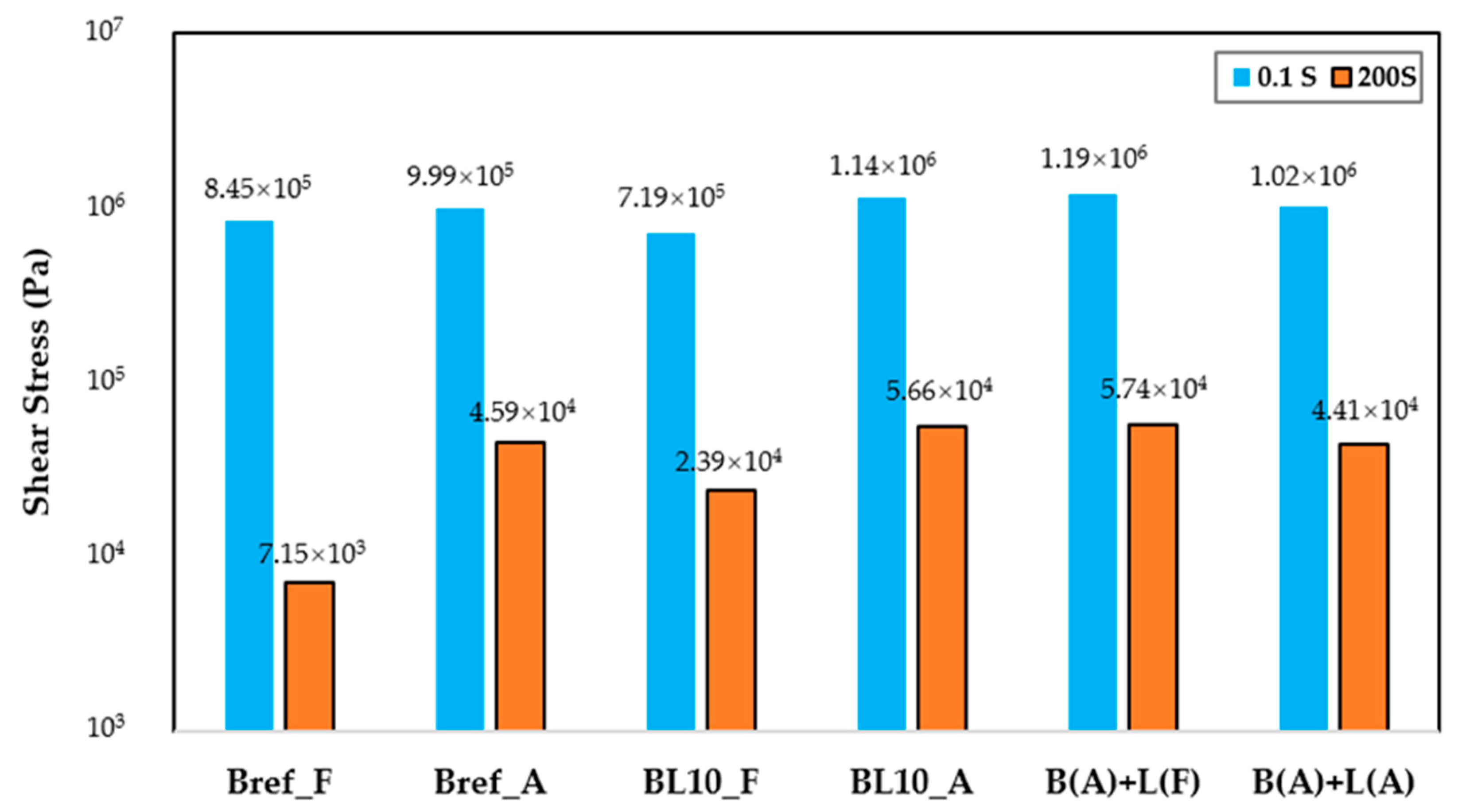
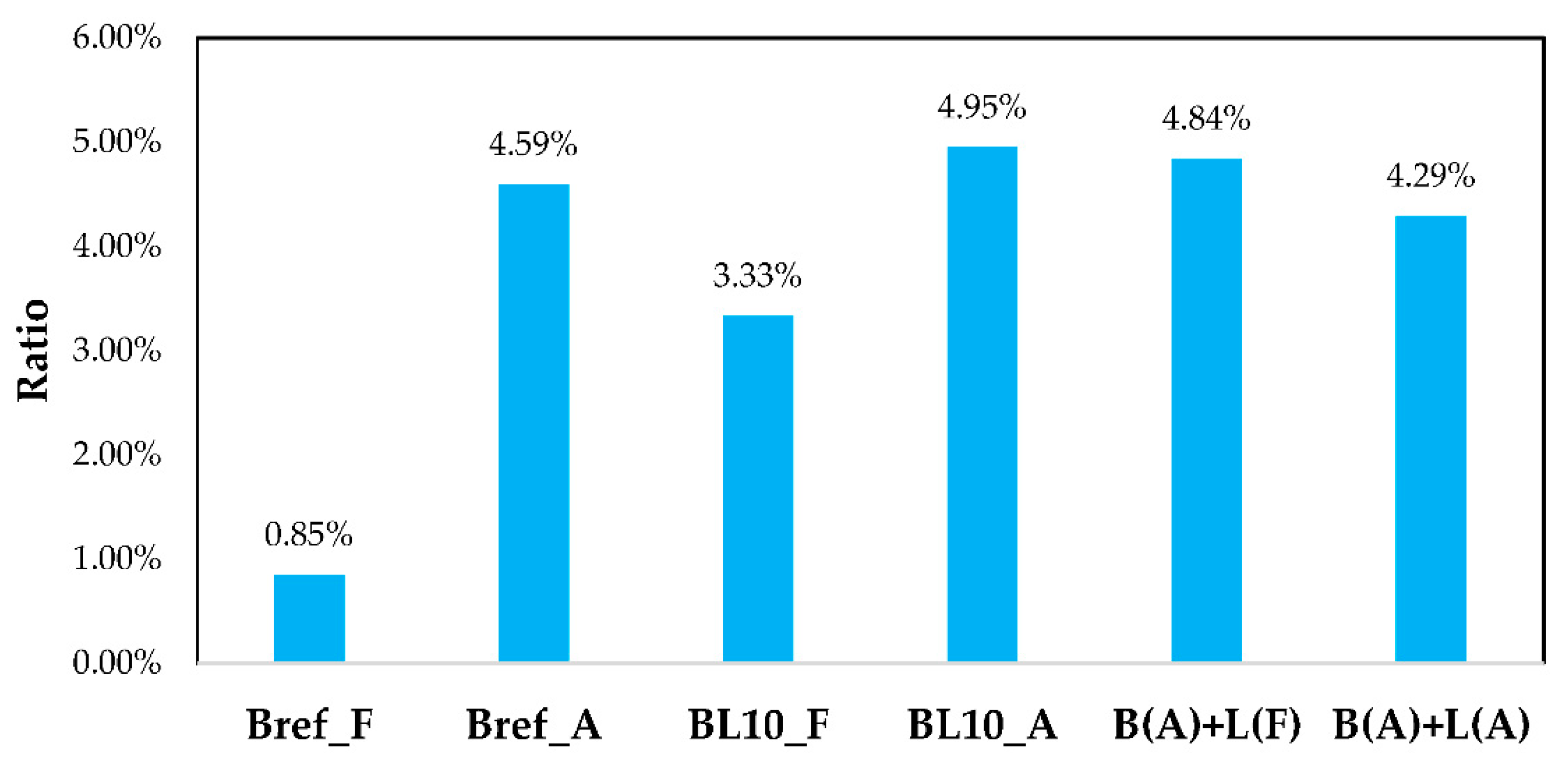
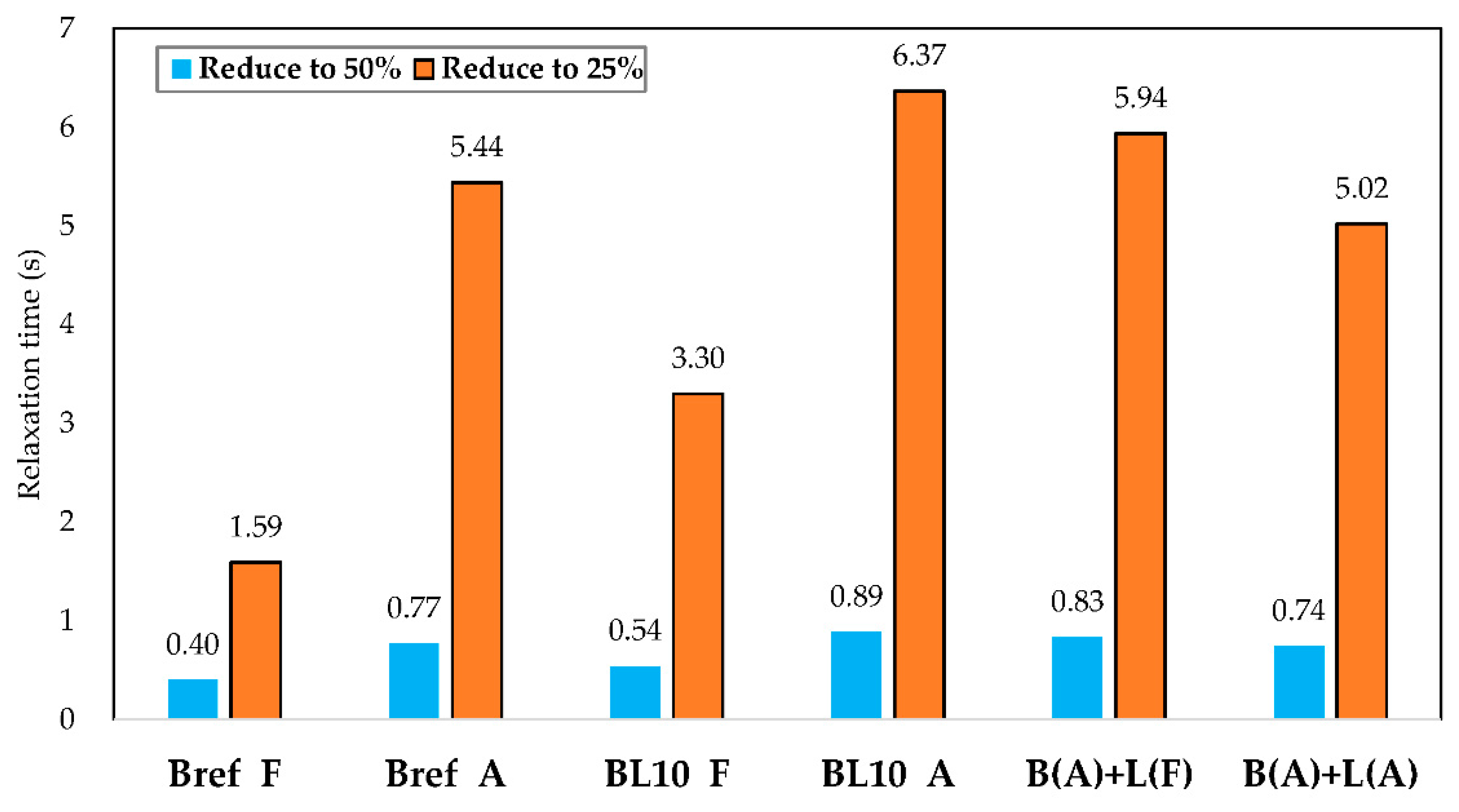
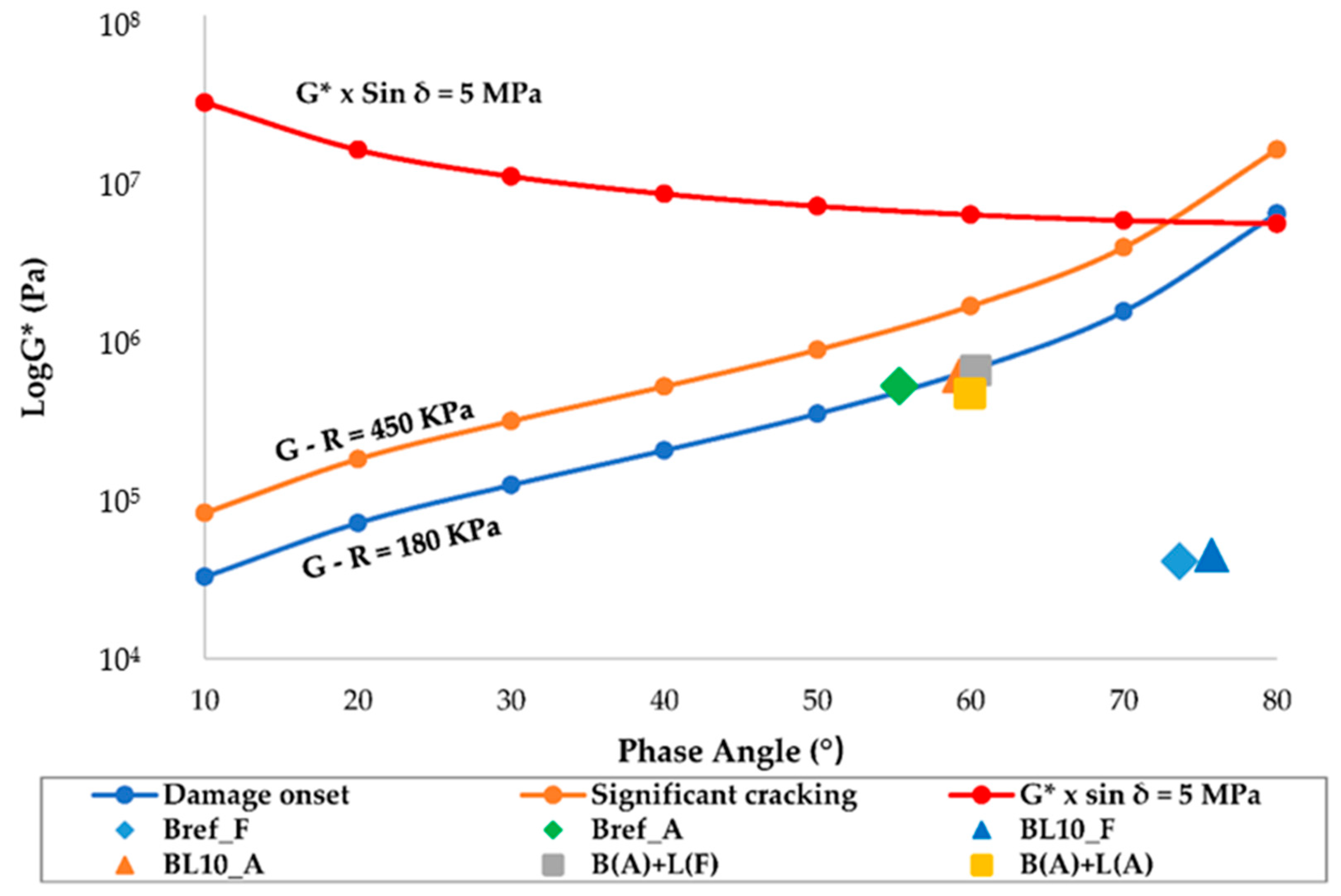
| Studied Materials | Modification by Bitumen Mass | Explanation |
|---|---|---|
| Bref_F | 0% | Fresh neat bitumen, as reference |
| Bref_A | Aged neat bitumen | |
| BL10_F | 10% | Fresh bitumen mixed with fresh lignin |
| BL10_A | Fresh bitumen mixed with fresh lignin, then aging | |
| B(A) + L(F) | Aged bitumen mixed with fresh lignin | |
| B(A) + L(A) | Bitumen and lignin aged separately, then mixing |
| Wavenumber (cm−1) | Function Groups |
|---|---|
| 3500–3100 | Stretching vibrations of –OH groups *1 |
| 1753–1660 | Stretching vibrations of C=O bonds *1 |
| 1620–1555 | Vibrations of aromatic ring *1 |
| 1525–1480 | Vibrations of aromatic ring *1 |
| 1280–1245 | Stretching vibrations of C–O bonds *1 |
| 1170–1140 | Deformation vibrations of C–H bonds in guaicyl rings *1 |
| 1140–1100 | Deformation vibrations of C–H bonds in syryngyl rings *1 |
| 1095–1070 | Deformation vibrations of C–O bonds in secondary alcohols and aliphatic ethers *1 |
| 1070–995 | Deformation vibrations of C–H bonds in the aromatic rings and C–O bonds in primary alcohols *1 |
| 2990–2880 | Stretching aromatic *2 |
| 2880–2820 | Stretching symmetric *2 |
| 1753–1660 | Oxygenated functional group (carbonyl) *2 |
| 1670–1535 | Aromatic structures *2 |
| 1525–1395 | Aliphatic structures *2 |
| 1390–1350 | Branched aliphatic structures *2 |
| 1047–995 | Oxygenated functional group (sulfoxide) *2 |
| 912–838 | Out of singlet *2 |
| 838–783 | Out of adjacent *2 |
| 783–734 | Out of adjacent *2 |
| 734–710 | Long chains *2 |
| Age State | Items | Absorbance Band Values (cm−1) | ||||||||
|---|---|---|---|---|---|---|---|---|---|---|
| 3420 | 1708 | 1597 | 1512 | 1269 | 1150 | 1125 | 1085 | 1032 | ||
| Fresh | Value | 0.2900 | 0.1640 | 0.1800 | 0.1772 | 0.0240 | 0.0095 | 0.0753 | 0.0054 | 0.0747 |
| SD | 0.0189 | 0.0098 | 0.0033 | 0.0033 | 0.0022 | 0.0010 | 0.0114 | 0.0004 | 0.0068 | |
| 1 PAV | Value | 0.2736 | 0.1796 | 0.1833 | 0.1824 | 0.0252 | 0.0120 | 0.0652 | 0.0053 | 0.0734 |
| SD | 0.0177 | 0.0050 | 0.0030 | 0.0040 | 0.0015 | 0.0011 | 0.0053 | 0.0007 | 0.0050 | |
| 2 PAV | Value | 0.2746 | 0.1770 | 0.1877 | 0.1813 | 0.0259 | 0.0123 | 0.0650 | 0.0056 | 0.0707 |
| SD | 0.0191 | 0.0049 | 0.0035 | 0.0035 | 0.0024 | 0.0012 | 0.0065 | 0.0005 | 0.0056 | |
| Studied Materials | |
|---|---|
| Bref_F | |
| Bref_A | |
| BL10_F | |
| BL10_A | |
| B(A) + L(A) | |
| B(A) + L(F) |
© 2019 by the authors. Licensee MDPI, Basel, Switzerland. This article is an open access article distributed under the terms and conditions of the Creative Commons Attribution (CC BY) license (http://creativecommons.org/licenses/by/4.0/).
Share and Cite
Zhang, Y.; Liu, X.; Apostolidis, P.; Gard, W.; van de Ven, M.; Erkens, S.; Jing, R. Chemical and Rheological Evaluation of Aged Lignin-Modified Bitumen. Materials 2019, 12, 4176. https://doi.org/10.3390/ma12244176
Zhang Y, Liu X, Apostolidis P, Gard W, van de Ven M, Erkens S, Jing R. Chemical and Rheological Evaluation of Aged Lignin-Modified Bitumen. Materials. 2019; 12(24):4176. https://doi.org/10.3390/ma12244176
Chicago/Turabian StyleZhang, Yi, Xueyan Liu, Panos Apostolidis, Wolfgang Gard, Martin van de Ven, Sandra Erkens, and Ruxin Jing. 2019. "Chemical and Rheological Evaluation of Aged Lignin-Modified Bitumen" Materials 12, no. 24: 4176. https://doi.org/10.3390/ma12244176
APA StyleZhang, Y., Liu, X., Apostolidis, P., Gard, W., van de Ven, M., Erkens, S., & Jing, R. (2019). Chemical and Rheological Evaluation of Aged Lignin-Modified Bitumen. Materials, 12(24), 4176. https://doi.org/10.3390/ma12244176







